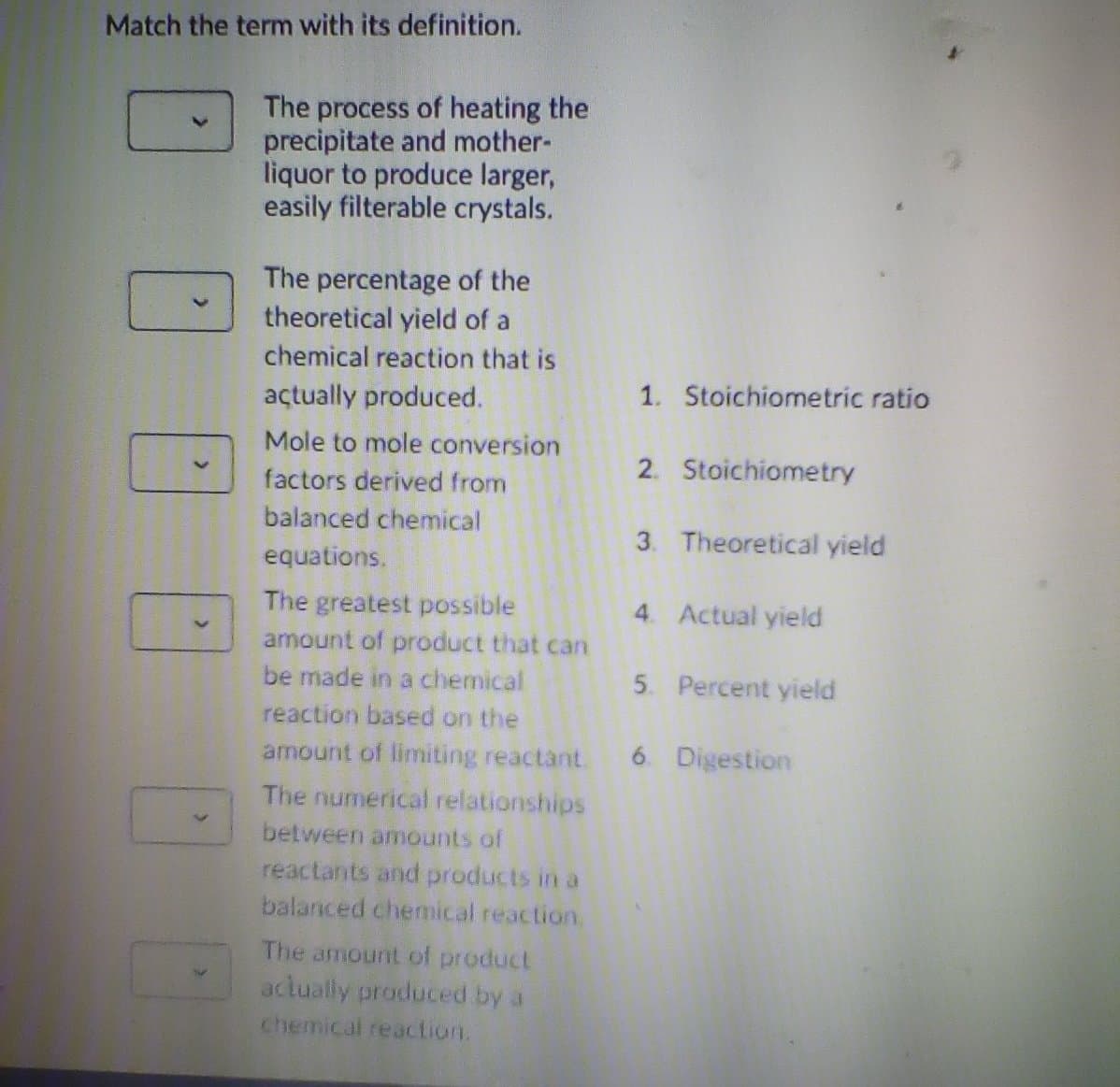The process of heating the precipitate and mother- liquor to produce larger, easily filterable crystals. The percentage of the theoretical yield of a chemical reaction that is açtually produced. 1. Stoichiometric ratio Mole to mole conversion 2. Stoichiometry factors derived from balanced chemical 3. Theoretical yield equations. The greatest possible amount of product that can 4. Actual yield be made in a chemical 5. Percent yield reaction based on the amount of limiting reactant. 6. Digestion The numerical relationships between amounts of reactants and products in a balanced chemical reaction. The amount of product aclually produced by a chemical reaction.
The process of heating the precipitate and mother- liquor to produce larger, easily filterable crystals. The percentage of the theoretical yield of a chemical reaction that is açtually produced. 1. Stoichiometric ratio Mole to mole conversion 2. Stoichiometry factors derived from balanced chemical 3. Theoretical yield equations. The greatest possible amount of product that can 4. Actual yield be made in a chemical 5. Percent yield reaction based on the amount of limiting reactant. 6. Digestion The numerical relationships between amounts of reactants and products in a balanced chemical reaction. The amount of product aclually produced by a chemical reaction.
Chemistry
10th Edition
ISBN:9781305957404
Author:Steven S. Zumdahl, Susan A. Zumdahl, Donald J. DeCoste
Publisher:Steven S. Zumdahl, Susan A. Zumdahl, Donald J. DeCoste
Chapter1: Chemical Foundations
Section: Chapter Questions
Problem 1RQ: Define and explain the differences between the following terms. a. law and theory b. theory and...
Related questions
Question

Transcribed Image Text:Match the term with its definition.
The process of heating the
precipitate and mother-
liquor to produce larger,
easily filterable crystals.
The percentage of the
theoretical yield of a
chemical reaction that is
açtually produced.
1. Stoichiometric ratio
Mole to mole conversion
2. Stoichiometry
factors derived from
balanced chemical
3. Theoretical yield
equations.
The greatest possible
amount of product that can
4. Actual yield
5. Percent yield
be made in a chemical
reaction based on the
amount of limiting reactant.
6 Digestion
The numerical relationships
between amounts of
reactants and products in a
balanced chemical reaction.
The amount of product
aclually produced by a
chemical reaction.
Expert Solution
This question has been solved!
Explore an expertly crafted, step-by-step solution for a thorough understanding of key concepts.
This is a popular solution!
Trending now
This is a popular solution!
Step by step
Solved in 2 steps

Knowledge Booster
Learn more about
Need a deep-dive on the concept behind this application? Look no further. Learn more about this topic, chemistry and related others by exploring similar questions and additional content below.Recommended textbooks for you

Chemistry
Chemistry
ISBN:
9781305957404
Author:
Steven S. Zumdahl, Susan A. Zumdahl, Donald J. DeCoste
Publisher:
Cengage Learning

Chemistry
Chemistry
ISBN:
9781259911156
Author:
Raymond Chang Dr., Jason Overby Professor
Publisher:
McGraw-Hill Education

Principles of Instrumental Analysis
Chemistry
ISBN:
9781305577213
Author:
Douglas A. Skoog, F. James Holler, Stanley R. Crouch
Publisher:
Cengage Learning

Chemistry
Chemistry
ISBN:
9781305957404
Author:
Steven S. Zumdahl, Susan A. Zumdahl, Donald J. DeCoste
Publisher:
Cengage Learning

Chemistry
Chemistry
ISBN:
9781259911156
Author:
Raymond Chang Dr., Jason Overby Professor
Publisher:
McGraw-Hill Education

Principles of Instrumental Analysis
Chemistry
ISBN:
9781305577213
Author:
Douglas A. Skoog, F. James Holler, Stanley R. Crouch
Publisher:
Cengage Learning

Organic Chemistry
Chemistry
ISBN:
9780078021558
Author:
Janice Gorzynski Smith Dr.
Publisher:
McGraw-Hill Education

Chemistry: Principles and Reactions
Chemistry
ISBN:
9781305079373
Author:
William L. Masterton, Cecile N. Hurley
Publisher:
Cengage Learning

Elementary Principles of Chemical Processes, Bind…
Chemistry
ISBN:
9781118431221
Author:
Richard M. Felder, Ronald W. Rousseau, Lisa G. Bullard
Publisher:
WILEY